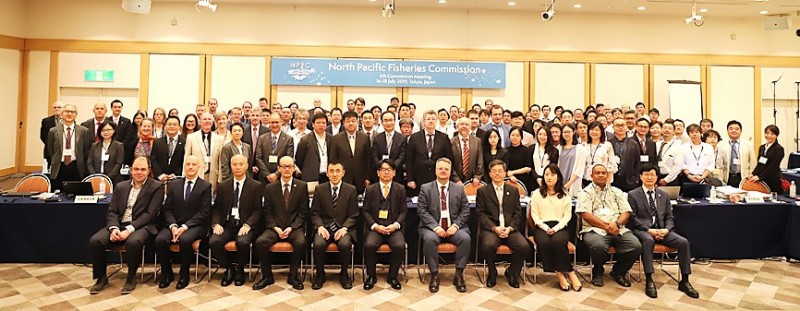《TAIPEI TIMES》 North Pacific fishers set quotas on saury catches

Attendees of the North Pacific Fisheries Commission’s fifth annual session pose for a group photograph on Thursday at the concluding ceremony of their three-day meeting at the Shinagawa Prince Hotel in Tokyo, Japan. Photo courtesy of the Fisheries Agency
OVERFISHING: The agreement passed after China and Vanuatu dropped their opposition. Taiwan’s quota of below 180,000 tonnes is manageable, authorities said
By Lin Chia-nan / Staff reporter
The North Pacific Fisheries Commission (NPFC) on Thursday agreed to set quotas for saury fishing next year, the Fisheries Agency said yesterday.
Taiwan, participating under the name Chinese Taipei, would limit its catch to less than 180,000 tonnes, the agency said.
Formally established in 2015, the group’s seven other members are Japan, Russia, China, South Korea, Vanuatu, Canada and the US, according to information on the commission’s Web site.
Nearly 90 Taiwanese ships operate in the North Pacific’s high seas from July to November every year, bringing back an average annual catch of 160,000 tonnes and making Taiwan one of the major consumers of the species, the agency said.
While the commission in 2015 launched measures to protect saury fry and limit member states’ fleet expansion, it did not set a cap on fishing volume until this year’s meeting in Tokyo, which was held from Tuesday to Thursday, the agency said.
The saury population has been declining due to overfishing, it said, citing studies by the commission.
The idea of placing a cap was broached by Japan, after its proposal last year failed to garner a consensus, Fisheries Agency Deputy-General Lin Kuo-ping (林國平) said.
China and Vanuatu, which opposed the measure last year, approved it this year, Lin said.
Effective next year, saury fishing in the exclusive economic zones of coastal countries and the North Pacific’s high seas would be limited to 556,250 tonnes, the agency said.
The volume might be re-evaluated in future meetings, Lin said, adding that it would be better to determine each member’s allowable catch to avoid potential conflict over quota division.
Member states are also required to limit their saury catch in the high seas to below last year’s level, which was 180,000 tonnes in Taiwan’s case.
That goal is not difficult to meet and would have a limited impact on Taiwanese fishers, Lin said.
Members are also advised not to work in waters 170 degrees east longitude from June to July every year to protect saury fry, a vital step in protecting the species’ breeding, the agency said.
The commission also passed other critical regulations about the vessel monitoring system, as well as conservation and management measures, it said.
Taiwan would amend its regulations in compliance with the commission’s new rules and keep working with other member states to ensure the sustainable use of saury resources, it added.
新聞來源:TAIPEI TIMES















